Activated Carbon Market Outlook - 2030
The global activated carbon market size was valued at $3.2 billion in 2020, and is projected to reach $5.8 billion by 2030, growing at a CAGR of 6.3% from 2021 to 2030.
Activated carbon is processed carbon with small and low-volume pores to increase surface area for chemical reactions and adsorption. Activated carbon is produced by processing organic material with high carbon content. Physical adsorption is main property of activated carbon, which is useful for purification, decaffeination, metal finishing, medicine, filters, removal of pollutant, and fuel storage. Liquid and gaseous phases of activated carbon enhance its uses in removal of lead, dissolved radon, mercury ,and other odor-causing compounds.
Health risks associated with drinking impure water are rising constantly among consumers. Improvement in drinking water treatments, growth in automobile ownership rates, and increase in manufacturing & environmental standards boost the growth of activated carbon market. Many counties, including China and India invest in water purification plants, which increases the demand for activated carbon. Increase in initiatives of government regarding subsidies and industrialization drives the growth of activated carbon market. Demand for mercury control technology for industrial air purification applications drives the market growth. Growth in market for activated carbon can be increased through geographic expansion and new product development.
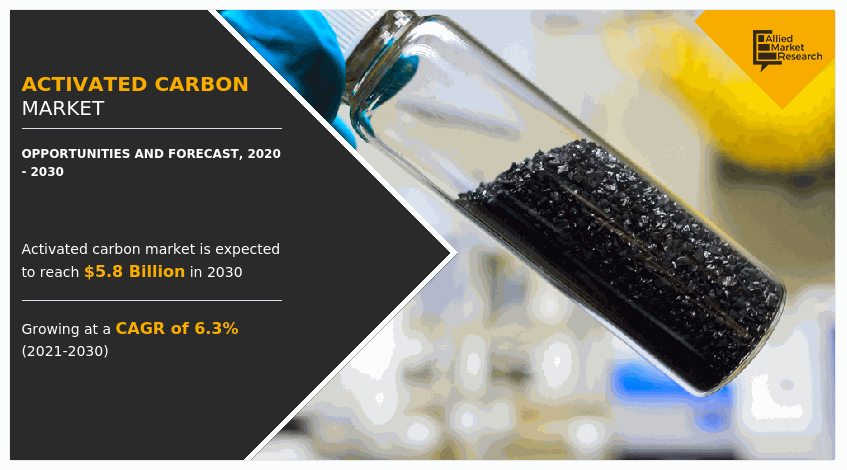
The activated carbon market is segmented into Product Type, Application and End-use Industry.
The activated carbon market is segmented on the basis of product type, end-use industry, application, and region. By product type, it is segmented into powdered, granular, and others. On the basis of end-use industry, it is classified into water treatment, food & beverage, pharmaceutical & medical, automotive, air purification, and other end-uses. According to application, it is segmented into liquid and gaseous. Region-wise, it is analyzed across North America, Europe, Asia-Pacific, and LAMEA.
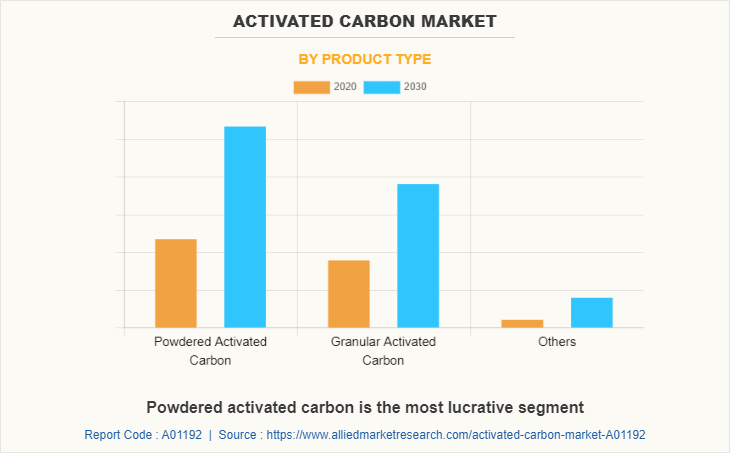
Activated Carbon Market By Product Type
The powdered activated carbon segment dominated the global activated carbon market in 2020, and is expected to maintain its dominance during the forecast period, owing to increase in demand for mercury removal plants at coal and other industrial plants, due to strict environmental regulations related to pollutant emissions.
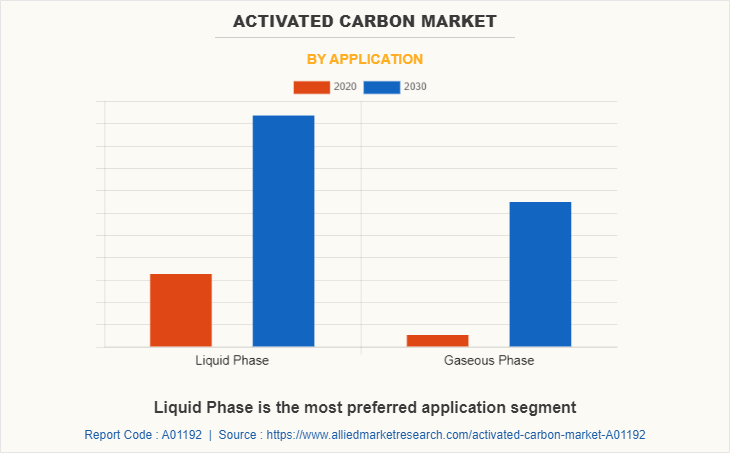
Activated Carbon Market By Application
The liquid segment dominated the global activated carbon market in 2020 and is expected to maintain its dominance during the forecast period, owing to increase in demand of wastewater treatment, groundwater remediation, chemical purification, food grade applications, pharmaceutical, potable water treatment, and removal of odor causing compounds, lead, dissolved radon, and chlorine.
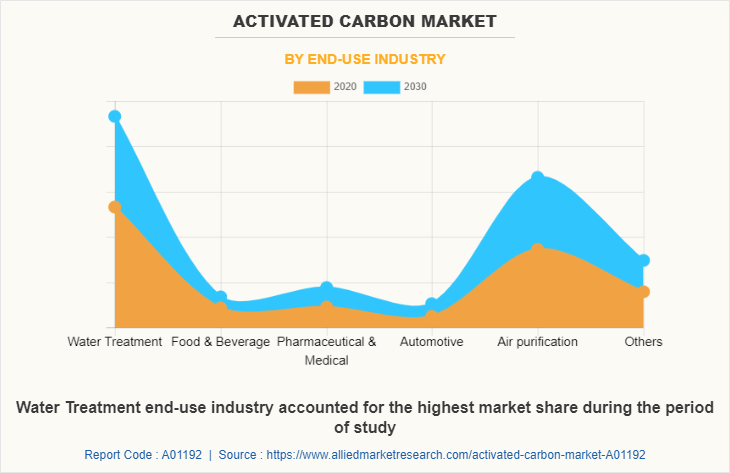
Activated Carbon Market By End Use Industry
The water treatment segment dominated the global activated carbon market in 2020, and is expected to maintain its dominance during the forecast period, owing to the increase in demand for water treatment processes which increased due to scarcity of water and rise in industrialization in near future which holds the opportunity for the growth of water treatment market.
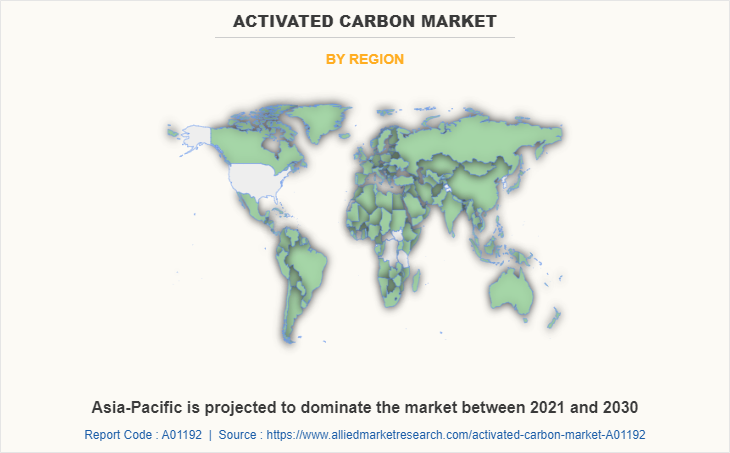
Activated Carbon Market By Region
Asia-Pacific accounted for the largest share of the activated carbon market in 2020. Asia-Pacific market for activated Carbon is expected to grow at the highest CAGR, in terms of both volume and value. Developing countries, such as China, India, and others, generate a very high demand for activated carbon, owing to increase in demand for automotive sector.
Key Benefits For Stakeholders
- This report provides a quantitative analysis of the market segments, current trends, estimations, and dynamics of the activated carbon market analysis from 2020 to 2030 to identify the prevailing activated carbon market opportunities.
- The market research is offered along with information related to key drivers, restraints, and opportunities.
- Porter's five forces analysis highlights the potency of buyers and suppliers to enable stakeholders make profit-oriented business decisions and strengthen their supplier-buyer network.
- In-depth analysis of the activated carbon market segmentation assists to determine the prevailing market opportunities.
- Major countries in each region are mapped according to their revenue contribution to the global market.
- Market player positioning facilitates benchmarking and provides a clear understanding of the present position of the market players.
- The report includes the analysis of the regional as well as global activated carbon market trends, key players, market segments, application areas, and market growth strategies.
Activated Carbon Market Report Highlights
| Aspects | Details |
| By Product Type |
|
| By Application |
|
| By End-use Industry |
|
| By Region |
|
| Key Market Players | Kureha Corporation, Jacobi Carbons AB, Cabot Corporation, Carbo Tech AC GmbH, Carbon Activated Corp., Siemens Water Technologies Corp., CLARINEX Group, Carbon Resources LLC, Calgon Carbon Corporation, ADA-ES, INC. |
Analyst Review
Activated carbon market holds a substantial scope for growth across the globe. Presently, the market is in its growth stage however, its contribution to global market would increase significantly during forecast period. Unavailability of raw material due to change in environment limits the growth of activated carbon market. However, recent R&D, which embed high efficiency and high adsorption in activated carbon enables market to reach a wider segment of consumers. New product launches and merger & acquisitions allow new players to come into market. Emerging need of safe water and air for consumption is expected to provide lucrative growth opportunity for the market.
Increasing need of water treatment plants due to water scarcity and pollutions is major driver of this market. Furthermore, strict environment regulations to control carbon and pollutants emission are increasing demand for activated carbon applications in of mercury removal plants. Activated carbon market is increasing with increase in industrialization and urbanization. Government is focusing to keep environment healthy in terms of safe water and air for living beings; moreover, providing subsidies to industries such as power generation industry to control pollution. High concerns about health issues by consuming contaminated water and air, by people, has increased the applications of activated carbon in purification, food & beverage, pharmaceutical & medical, automotive and many more. High price of raw material is restricting growth of market. Moreover, high pollution level, high per capita income, new product developments and launches is creating opportunity to boost growth of activated carbon market in upcoming years.
The growth drivers, restraints, and opportunities are explained in the report to better understand the market dynamics. This report further highlights the key areas of investment. In addition, it includes Porter’s five forces analysis to understand the competitive scenario of the industry and role of each stakeholder. The report features the strategies adopted by key market players to maintain their foothold in the market. Furthermore, it highlights the competitive landscape of the key players to increase their market share and sustain intense competition in the industry.
Increase in demand of wastewater treatment, groundwater remediation, chemical purification, food grade applications, pharmaceutical, and potable water treatment, removal of odor causing compounds and removal of lead is expected to boost the activated carbon market growth.
The market value of global activated carbon market in 2021 is expected to be $3.3 billion and projected to rise to $5.8 billion in 2030.
The leading players in the market ADA-ES, INC., Jacobi Carbons AB, Siemens Water Technologies Corp., Kureha Corporation, Calgon Carbon Corporation, Carbo Tech AC GmbH, Carbon Resources LLC, CLARINEX Group, Carbon Activated Corp., and Cabot Corporation.
The global activated carbon market is segmented on the basis of derivative product type, application, end use industry and region.
Due to COVID-19 pandemic, transport limitations were implemented, resulting in reduced industrial production and disrupted supply chains, which affected global economic growth by a substantial proportion, severely impacting market growth.
Loading Table Of Content...



